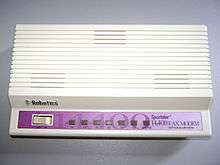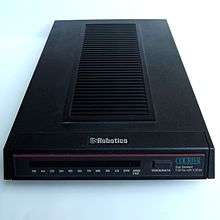USRobotics
|
| |
| Private | |
| Industry | Computer |
| Founded | 1976 (40 years ago) |
| Headquarters | Schaumburg, Illinois |
| Products | Modems, Wired and Wireless Networking, VoIP |
| Owner | UNICOM Global |
| Website |
www |
U.S. Robotics Corporation, often called USR, is a company that produces USRobotics computer modems and related products. Its initial marketing was aimed at bulletin board systems, where its high-speed HST protocol made FidoNet transfers much faster, and thus less costly. During the 1990s it became a major consumer brand with its Sportster line. The company had a reputation for high quality and support for the latest communications standards as they emerged, notably in its V.Everything line, released in 1996.
With the reduced usage of analog or voiceband modems in North America in the early 21st century, USR began branching out into new markets. The company purchased Palm, Inc. for its PalmPilot PDA, but was itself purchased by 3Com soon after. 3Com spun off USR again in 2000, keeping Palm and returning USR to the now much smaller modem market. After 2004 the company is formally known as USR. It is one of the few companies left in the modem market today, and now employs about 125 people worldwide.[1]
History
USR was founded in 1976 in Chicago, Illinois (and later moved to Skokie, Illinois), by a group of entrepreneurs, including Casey Cowell, who served as CEO for most of the company's history, and Paul Collard who designed modems into the mid-1980s. The company name is a reference to the fiction of Isaac Asimov, who is credited with inventing the term robotics. Asimov's robot stories featured a fictional company named U.S. Robots and Mechanical Men. Cowell stated at a popular BBS convention they named the company as an homage to Asimov and because in his science fiction works U.S. Robots eventually became "the biggest company in the universe". (The later 2004 movie I, Robot, which was loosely based on Asimov's works, and set in Chicago, used the name "U.S. Robotics" for the fictional robot manufacturer. The movie's U.S. Robotics corporate logo resembles a former nonfictional USR logo. Following the release of the movie, the company officially changed its name to USR.)
USR was one of many companies to offer dial-up modems for personal computers. Prior to the development of standards such as the V.32 family of protocols, USR introduced its own HST (High-Speed Transfer) protocol in 1986, which operated at 9600 bit/s (bits per second). In 1989 HST was expanded to 14.4 kbit/s, 16.8 kbit/s in 1992, and finally to 21 kbit/s and 24 kbit/s.
USR was not the only company making modems with proprietary protocols; Telebit's TrailBlazer series offered speeds up to 19.2 kbit/s in its first model, and Hayes also introduced the 9600 bit/s Express 96 (or "Ping-Pong") system. However, USR became the most successful of the three, due to a marketing scheme that offered large discounts to BBS sysops.

The proprietary nature of HST allowed USR to maintain its market predominance even when off-brand V.32-based modems began selling for less than equivalent HST modems. As the price differential decreased, however, V.32-based modems eventually became a cost-effective alternative to HST. Nevertheless, USR countered by creating slightly faster HST protocols, notably a 16.8 kbit/s mode, and by producing "dual-standard" modems that were able to communicate with both HST and V.32 modems at high speeds.
During this period, USR differentiated between its high and low-end product lines by supporting only the V.32 modes on its low-end Sportster models, while its high-end Courier models supported V.32, HST, or both in the Courier Dual Standard models. The Sportster used the same motherboard as the Couriers, and on certain 14.4 kbit/s models a sequence of AT commands could be issued to enable the faster 16.8 kbit/s HST mode.[2] The Courier modems remained a favorite in the BBS and emerging Internet service provider world, where they were known to run without problems for extended periods of time (although the initial large-scale deployment of Courier modems in the CompuServe network uncovered a serious bug, which would cause the modems to crash and stop answering calls under high call volumes).
_(public_domain).jpeg)

A similar situation emerged a few years later when the 56kbit/s V.90 standard was first being proposed. USR developed its own 56k standard known as X2, while a consortium of other companies introduced its own K56flex. In contrast to the success of HST, neither X2 nor K56flex saw any real market uptake, as it was clear they would soon be followed by V.90 modems. After the introduction of V.90, USR abandoned support for X2. In a further effort to reduce the retail price of its modems, USR also marketed a Winmodem that used software running on the host computer to perform some of the modem functions.
Some models of Courier modems were known for their long-term upgradeability, because they used an upgradeable DSP design. For example, when the Courier V.Everything modem was first released in 1994 under the product label "Courier V.34 Ready", it shipped with only V.FC support, because V.34 had not been released. A free V.34 upgrade was made available later via FidoNet, as well as the Internet. USR then surprised many early Courier V.Everything modem owners with a limited-time free offer of an X2 firmware upgrade, which added 56K speed capability. Finally, USR released a V.90 upgrade that was compatible with X2-upgraded Courier V.Everything modems. Even the 1994 hardware released pre-V.34 was fully V.90-upgradeable without hardware modification.
There was a licensing key needed for some Courier V.Everything V.90 flash upgrades. The firmware could be loaded onto the modem, but it would work in "degraded" V.34 mode. After paying a fee, and having the modem dial USR, a license key was installed that enabled the V.90 functions.
Commoditization
After acquiring Palm, Inc., in 1995, USR merged with 3Com Corporation in June 1997.[3] It was then recreated as a spin-off of 3Com in June 2000, assuming 3Com's entire client modem business except for the Palm-related portion, which itself had been spun off with Palm three months earlier. Other portions of the original USR remained part of 3Com as the CommWorks Corporation. USR then quickly built up its device portfolio, including not only traditional dial-up modems, but also wired- and wireless-networking components.
USR was acquired by private equity firm Platinum Equity for an undisclosed amount of cash in 2005, believed to be between US$30 million and US$50 million.[4]
By 2010 the company was focused only on the traditional modem business.
In 2013, USR was acquired by UNICOM Global.[5]
See also
- IBM Mwave – Combined modem and sound digital signal processor (DSP) card allowing soft upgrades within its hardware limitations.
References
- ↑ www.usr.com/press/pr-backgrounder.asp
- ↑ groups.google.com/group/comp.dcom.telecom.tech/browse_frm/thread/4b07122a94a43b50
- ↑ news.cnet.com/Investors-bless-3Com-USR-merger/2100-1001_3-200418.html
- ↑ www.ecommercetimes.com/story/45484.html?welcome=1218602835
- ↑ http://support.usr.com/press/pr-press-release.asp?prid=693
External links
| Wikimedia Commons has media related to U.S. Robotics. |
- Official website of U.S. Robotics Corporation
- Corporate press kit that discusses origin of company name (pdf)
- Article discussing the Asimov-USR connection and USR's marketing tie-ins to the movie
-
- Business data for U.S. Robotics Corporation: Google Finance
- Yahoo! Finance
- Hoover's